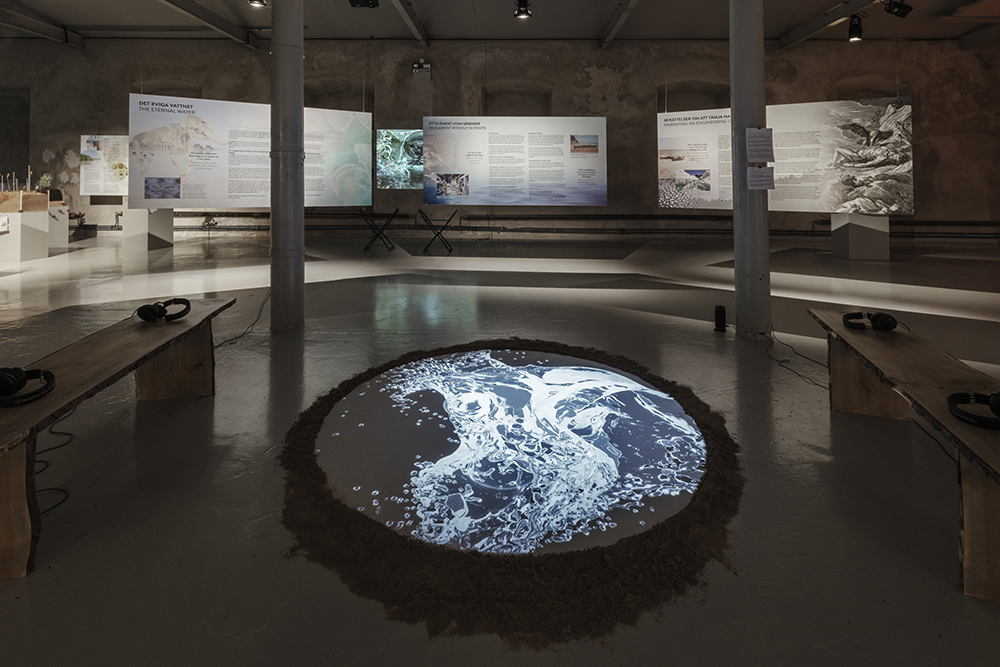Urban water imaginaries in exhibition - co-creative dialogues between science, art, and engineering

The exhibition Symbiosis at Färgfabriken is a place for dialogue and an ongoing experiment created together with artists, researchers, designers and architects to explore new ways of thinking about our world and the challenges facing humanity. The goal is for collaboration between research and art to promote a new kind of open dialogue on challenges that await infrastructure as a result of climate change.

The starting point for what Katarina Larsen at the Department of Philosophy and History and her colleagues Timos Karpouzoglou and David Nilsson research is about how artistic descriptions of infrastructure for water can lead reflections on societal challenges where dialogue with a wider audience is crucial. It is precisely the visual communication and stories about change in urban areas that the discussion about the different roles of science is connected to their research project NATURE, funded by the Riksbank's Jubilee Fund.
– We want to start a discussion about how art can act as a catalyst to raise important scientific issues in society. It is an exciting interface where we want to create a dialogue between artists, researchers and visitors around visual stories, scientific concepts and engineering solutions for water. This is what we have worked with in NATURE and with Färgfabriken, to create a place for that dialogue through the exhibition Symbiosis.
Anders Bergmark, who is Partner Director at Färgfabriken, describes the process as:
“Färgfabriken does not know in advance how the symbiosis between researchers and artists will end. This is what is exciting and contributes to unexpected results. In the current collaboration with KTH's researchers, the process itself has gradually created new insights and images for the various parties. It is exciting to see if researchers and artists together, with their different approaches, can find new expressions and ideas.”
Co-creativity among researchers and artists
The exhibition, which is part of the project, functions as an interaction between researchers and artists where questions are raised about how it is possible to create space and conditions for the learning process, how it is possible to reach out with questions and investigate alternative ways of solutions to water systems for access to water.
– As researchers, we must reach out with the research we conduct and then visual means is a powerful strategy. It is an argument for making this type of presentation of research. We learn from what we experience, absorb things through experience. It therefore becomes important to experience things in order to actually understand them. How we can describe and shape issues so you can take it in with several senses is the strength of such collaborations. We started work on the exhibition in the spring of 2020, and it was special doing so during the pandemic with digital meetings. We thought about how to create this co-creative process and what is required. We realized that it takes a lot of time for conversations in the project. I think it is important to realize that different skills are needed. The artist has his point of view, while we have other inputs as researchers. So it is good to be prepared to learn things you did not know you were going to learn before you start. It has also been important to keep track of rules and different conditions and understanding of artistic working methods, so we could meet and everyone becomes a winner in the collaboration.
A creative narrative technique
NATURE focuses on narrative inquiry, which means that the focus is on producing several different stories from engineers and planners about the interaction between nature and society. Creative techniques, such as photographs, toy models of infrastructure and participation in the exhibition Symbiosis are examples of how the project intends to explore new ways of communicating ideas about infrastructure.
– In the exhibition, we use, among other things, narratives about Prometheus from Greek mythology to discuss issues of engineering and societal challenges. He wanted to give man tools that could help the development of mankind but was also punished by the god Zeus for his actions. The process of the exhibition has taken place through an open dialogue and open discussion. We started talking to Färgfabriken and the artist Åsa Cederqvist and then the dialogue and discussion started. Then we not only became researchers who write, but we reached out and started a dialogue process where the artist has been part of the project group. We asked how we can develop and highlight different concepts around water and water quality and how visual art with AR (Augmented Reality) can be used. She has interpreted it and through image and sound created a part of the exhibition that describes, discusses and gives examples of stories about water in cities. How can water be described? Does it have its own rights? How can they be asserted? It is inspiring to now that the exhibition has opened at Färgfabriken see how visitors sit down and interact at the source, which is a meeting place. There you can listen to the sound installation and see a digital pond with projections of water in all its forms, including dirty and polluted.
An ongoing dialogue with visitors
The exhibition also provides an opportunity to gather experiences through an interactive part where questions are asked to visitors. There, visitors can key in answers to questions about water and their relationship to it. In order for the research group to then be able to observe and reason about the results.
– We are curious about what we will see from the interactive parts with the visitors and what they are prepared to give up. Can parks act as a buffer and be flooded at times? Can they imagine rinsing with rainwater? Shower less? Is it more difficult with such issues that are changes up close, perhaps community planning is easier to imagine? It is about how cities plan so they can handle new coming challenges.
The exhibition provides an opportunity for different groups to visit and reflect on these issues and the goal of reaching those who are otherwise a little out of the discussion.
– By using images and text, different groups of people can absorb the information in different ways. The exhibition might welcome engineers, city planners, school classes and people who live in the immediate area. What impressions do the different groups bring with them? How do we reach different groups? We have worked with imagery and dialogues and different types of storytelling. Collaboration with artists is a way to create a narrative.
Filling knowledge gaps for future engineers
Through the work, they also ask themselves what today's knowledge of water quality looks like and how engineers should be trained to be able to meet these challenges that come our way. The exhibition will also be part of a course on urban transformation and sustainability in a course that Katarina Larsen holds at KTH (Society, culture and industry in Sweden from a historical perspective) where course participants will be able to visit Symbiosis at Färgfabriken.
– Then international future engineers get to visit, and we get to take in their reactions. What skills do they need to bring to work with these challenges? It will be a critical reflection and a discussion about sustainability with the engineers of the future.
Katarina Larsen and her colleagues want to promote user-based research projects and to include many different skills and see different people's views on problems. To start a discussion about this, they have also presented some points of departure at the Streams conference at KTH 2021 about why dialogue is important.
– We learn from working with different skills and understand other perspectives. It is valuable to learn to change perspectives and see others' views on the problem. There are also users' perspectives that I think are important. Then we can create robust and smart solutions. Of course it takes time but it is worth investing that time. It is also very fun to be able to see the exhibition inspire others and see the dialogue that arises. In the project we will have workshops for different professional groups. We have also been told that many school classes have now booked visits to the exhibition, so it is very fun to see that the work with the exhibition reaches out and can inspire conversations about new solutions.
This is the 13th article in the
